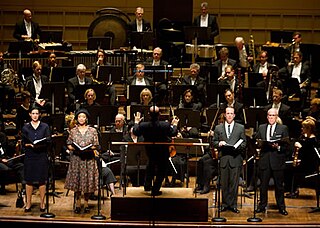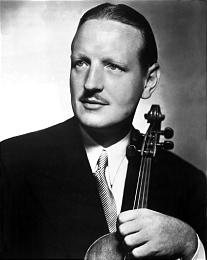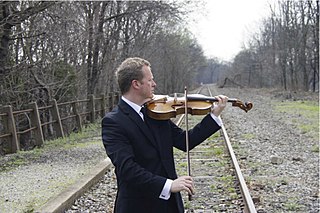Related Research Articles

Orchestration is the study or practice of writing music for an orchestra or of adapting music composed for another medium for an orchestra. Also called "instrumentation", orchestration is the assignment of different instruments to play the different parts of a musical work. For example, a work for solo piano could be adapted and orchestrated so that an orchestra could perform the piece, or a concert band piece could be orchestrated for a symphony orchestra.
Joan Tower is a Grammy-winning contemporary American composer, concert pianist and conductor. Lauded by The New Yorker as "one of the most successful woman composers of all time", her bold and energetic compositions have been performed in concert halls around the world. After gaining recognition for her first orchestral composition, Sequoia (1981), a tone poem which structurally depicts a giant tree from trunk to needles, she has gone on to compose a variety of instrumental works including Fanfare for the Uncommon Woman, which is something of a response to Aaron Copland's Fanfare for the Common Man, the Island Prelude, five string quartets, and an assortment of other tone poems. Tower was pianist and founding member of the Naumburg Award-winning Da Capo Chamber Players, which commissioned and premiered many of her early works, including her widely performed Petroushskates.

Steven Edward Stucky was a Pulitzer Prize-winning American composer.

The Viola Concerto, Sz. 120, BB 128 was one of the last pieces written by Béla Bartók. He began composing his viola concerto while living in Saranac Lake, New York, in July 1945. The piece was commissioned by William Primrose, a respected violist who knew that Bartók could provide a challenging piece for him to perform. He said that Bartók should not "feel in any way proscribed by the apparent technical limitations of the instrument"; Bartók, though, was suffering from the terminal stages of leukemia when he began writing the viola concerto and left only sketches at the time of his death.
Nigel Keay is a New Zealand composer. He has been a freelance musician since 1983 working as a composer, violist, and violin teacher. Nigel Keay has held the following composer residencies: Mozart Fellowship, University of Otago 1986 and 1987, Nelson School of Music 1988 and 89, Auckland Philharmonia Orchestra 1995.
Margaret Brouwer b. Ann Arbor, Michigan, February 8, 1940 is an American composer and composition teacher. She founded the Blue Streak Ensemble chamber music group.
Victoria Ellen Bond is an American conductor and composer.
Der gerettete Alberich is a concerto for percussion and orchestra by the American composer Christopher Rouse. The work was jointly commissioned by the London Symphony Orchestra, the Cleveland Orchestra, the Philadelphia Orchestra, and the Baltimore Symphony Orchestra. It was completed June 7, 1997, and premiered January 15, 1998 in Cleveland, Ohio with the Cleveland Orchestra under conductor Christoph von Dohnányi. The piece is dedicated to percussionist Evelyn Glennie, who performed the solo during the world premiere. Rouse composed the work as an informal musical sequel to Richard Wagner's four-opera cycle Der Ring des Nibelungen.
The Concerto for Orchestra is an orchestral composition in five movements by the American composer Jennifer Higdon. The work was commissioned by the Philadelphia Orchestra with contributions from the National Endowment for the Arts, the Philadelphia Music Project, and Peter Benoliel. It was premiered at the Kimmel Center for the Performing Arts in Philadelphia June 12, 2002, with conductor Wolfgang Sawallisch leading the Philadelphia Orchestra.
The Viola Concerto is a composition for solo viola and orchestra by the American composer Nico Muhly. Composed in 2014, the work was jointly commissioned by the Orquesta Nacionales de España, the Detroit Symphony Orchestra, Festival de Saint Denis, and the National Arts Centre Orchestra. It was first performed on February 6, 2015 by the violist Nadia Sirota and the Orquesta Nacionales de España under the conductor Nicholas Collon. The piece was later given its United States premiere on October 23, 2015, by Sirota and the Detroit Symphony Orchestra under Leonard Slatkin.
The Concerto for Orchestra is an orchestral composition by the American composer Joan Tower. The work was jointly commissioned by the St. Louis Symphony, the Chicago Symphony Orchestra, and the New York Philharmonic.
The Concerto for Clarinet is a composition for solo clarinet and orchestra by the American composer Joan Tower. The work was commissioned by the Walter W. Naumburg Foundation for the clarinetist Charles Neidich, to whom the piece is dedicated.
The Concerto for Flute is a composition for solo flute and orchestra by the American composer Joan Tower. The work was commissioned by the American Composers Orchestra and was composed in 1989. It was first performed at Carnegie Hall on January 28, 1990, by the flutist Carol Wincenc and the American Composers Orchestra under the conductor Hugh Wolff. The piece is dedicated to Carol Wincenc.
The Concerto for Orchestra is an orchestral composition by the American composer Marc Neikrug. The work was commissioned by the New York Philharmonic and was completed in May 2011. It was given its world premiere by the New York Philharmonic under the conductor Alan Gilbert at Avery Fisher Hall on April 26, 2012. The concerto is dedicated to Alan Gilbert.
The Oboe Concerto is a composition for solo oboe and orchestra by the American composer John Harbison. The work was commissioned by the San Francisco Symphony for its principal oboist William Bennett. It was completed on October 18, 1991, and was given its world premiere by Bennett and the San Francisco Symphony under the conductor Herbert Blomstedt in 1992.
The Concerto for Viola and Orchestra is a viola concerto by the American composer John Harbison. The work was commissioned by the Saint Paul Chamber Orchestra, the Los Angeles Chamber Orchestra, and the New Jersey Symphony Orchestra with contributions from Meet The Composer and Reader's Digest. It was first performed by Jaime Laredo and the New Jersey Symphony Orchestra under the direction of Hugh Wolff on May 18, 1990.
The Viola Concerto is a composition for solo viola and orchestra by the American composer Peter Lieberson. The music was commissioned by the Toronto Symphony Orchestra and the Symphony Nova Scotia for Steven Dann, the principle violist of the Toronto Symphony. It was completed in 1992, though Lieberson later revised the work in 2003. The work is dedicated to Steven Dann.
The Viola Concerto is a composition for viola and orchestra by the Scottish composer James MacMillan. The work was jointly commissioned by the London Philharmonic Orchestra, the Lucerne Symphony Orchestra, the Bergen Philharmonic Orchestra, and the Adelaide Symphony Orchestra. Its world premiere was given by the violist Lawrence Power and the London Philharmonic Orchestra under the direction of Vladimir Jurowski in the Royal Festival Hall, London, on 15 January 2014. The piece is dedicated to Lawrence Power.

Brett Deubner is an American violist. He has performed as concerto soloist with over 70 orchestras on four continents.
Eros Piano is a piano concerto written by the American minimalist composer John Adams. The work was commissioned by the Koussevitzky Music Foundation in 1984 and was completed in 1989. Its world premiere was performed by the pianist Paul Crossley and the London Sinfonietta conducted by Adams on November 24, 1989, in Queen Elizabeth Hall, London. The piece is dedicated to Paul Crossley. It is the first of three piano concertos by Adams, followed by Century Rolls in 1996 and Must the Devil Have All the Good Tunes? in 2018.
References
- 1 2 3 4 5 Tower, Joan (2005). "Purple Rhapsody". G. Schirmer Inc. Retrieved January 21, 2016.
- ↑ Kozinn, Allan (June 8, 2010). "Stylistically Omnivorous and Erasing Boundaries". The New York Times . Retrieved January 21, 2016.
- ↑ Freedman, Geraldine (October 2, 2008). "Glens Falls Symphony Orchestra to reprise work to mark composer's birthday". The Daily Gazette . Retrieved January 21, 2016.